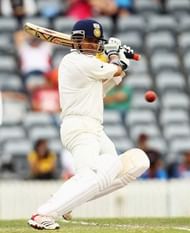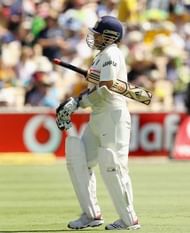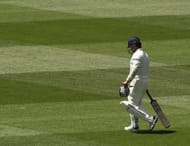The concept of dual role isn’t new to the Indian audience. They embark into the world of Hindu mythology with characters playing more than one role, right in their childhood. Ramayana and Mahabharata have stories to elicit the same. Indian cinema has never failed to deliver smash hits with super stars playing dual roles. Amitabh Bachchan’s Kasme Vaade, Don are part of Bollywood’s folklore. Down south people rave Rajinikanth’s Thillu Mullu even today. The characterizations of AAK Chandran and Indiran are epics in their own right. In cinema, dual roles give the actors a chance to show their versatility with characters that are black and white. But on a cricket field, it is not often that players change colors. When they do, more often than not it is questioned and criticized.
My earliest memory of Sachin Tendulkar remains as the man who was the only Indian batsman to torment bowling attacks. In that Indian line up only one man could consistently scorch magnificence. To an extent, Mohammed Azharuddin made his presence felt with some eloquent flicks.
1998 remains his best cricketing year. I remember how he took on that Australian attack, not once but twice at Bangalore and Chennai. At both instances where he went over a personal score of 150, Tendulkar not only smashed the leather but dented the confidence of one of the legends of cricket named Shane Warne. He was arguably the best player of spin in his era. The 90s saw Tendulkar stand tall over some really tough challenges against Shane Warne, Saqlain Mushtaq and Muthiah Muralitharan. His foot movement could best be described as a silky dance down to connect the leather with the willow. The straight bat and the loft over bowlers’ head will go down memory lane! During both these special tons his strike rate was well above 80 runs per 100 balls.
Tendulkar rarely lets the tempo down when he dons the blue jersey for India. I was stunned to see Tendulkar’s strike rate hover around the 90s in the 50 over format. That number fascinated me even more when I put that against my personal favorite and idol, Sourav Ganguly’s strike rate. Tendulkar’s ability to play more than 2 strokes for any delivery at any point of time in the game was one of the reasons to help him score runs freely than his peers.
One of my favorite moments was best described by John Wright in his book, Indian Summers. It was the big India-Pakistan game in the 2003 World Cup. He goes on to say, “As our openers walked down the long flight of stairs to begin the chase, Viru told Sachin, ‘Don’t say anything to me about my batting except “go and lagaao”’ – basically, go for it. Sachin replied, ‘I’m going to get these guys.’ Such was his intent.
Bangalore which witnessed the destructive Tendulkar in 1998, hosted a test against Pakistan in 2005. Against the likes of Arshad Khan, Danish Kaneria and Shahid Afridi, I remember Tendulkar struggling to tick off a single. It was a moment so unreal that I had to pinch myself to understand the reality. It was true that, India were staring down the barrel with a mountain to climb. Tendulkar was losing partners at the other end. Between a space of 16 overs, Indians lost the trio of Laxman, Dravid and Ganguly. All this while, Tendulkar was the witness at the non-striker’s end.
Quite strikingly, I found a defensive Tendulkar hard to concur. The famous BBC Sport which quoted, “Beneath the helmet, under that unruly curly hair, inside the cranium, there is something we don’t know, something beyond scientific measure”, had a different meaning altogether. The agony came to an end when he was eventually dismissed for 16 off 98 balls. On another day, he would have taken the Pakistani spinners to the cleaners.
Moments such as these are very few to deeply analyze and correlate. But as time has passed by, I witnessed more of the defensive Tendulkar who shuts the shop way too early.
India went into the Cape Town test of 2007, with the series leveled 1-1. After piling up 414 runs in the first innings, the game was all in India’s hands. And they let the South Africans into the game with their defensive stroke play yet again. This time again, Tendulkar was in the middle when the game started to change. Tendulkar and Dravid crawled against the left-arm spin of Paul Harris. They blocked. They jabbed. They poked. They choked. For a little over 15 overs, the partnership garnered 14 runs at a pace slower than snail’s average speed.
It would remain one of Tendulkar’s most ignominious knocks ever. 14 runs came off his bat in 62 balls when the game had to move on! South Africa comfortably pouched on this phase of play and ended up winning the test. These are moments that let you wonder why a champion batsman like him would get too much on the defensive.
Just a year ago, he was on the duel against a top quality fast bowler from South Africa. So you cannot clearly attribute to these defensive tactics to his age. You wonder why Tendulkar even reveres some of these spinners he played defensively against. It wasn’t against a Muralitharan or Shane Warne he chose the option. It was against the lesser known mortals has Tendulkar struggled on occasions.
The tour down under was a hugely expected event for Tendulkar fans. The rivalry Tendulkar holds against the Aussies is as old and nicely scripted as the celtiberian tombstone from Clunia depicting the man versus bull fight in Rome. Each time, he has toured the toughest backyard in world cricket, Tendulkar has managed to rack in at least one hundred to his name. This year though he failed to convert the one hundred the world looked up to.
When he walked into bat this time, he had that extra baggage of 100th ton loaded on his shoulders. He might shrug off saying he wasn’t thinking of the landmark. His team-mates might say they looked at the bigger picture. But certain instants showed that the record overweighed the present situation much more than it has to. In a way, that pushed him down too.
He sparkled at Melbourne with a fluent half-century in the first innings. If cricket was a boxing ring, he always wished to deliver the opening punch in a heavy-weight encounter. I remember how he came out with all guns blazing at Mumbai (2001) against the same opponents. This innings which started on the right note ended very bizarrely at the end of the day. Somewhere at the corner of his mind, I felt he shut the shop off, a little earlier than he would usually do.
While Dravid had to battle against getting castled again and again, the experts believed Tendulkar played the same ball far better than Dravid. In short, he looked in song until the catastrophe struck. Once again, in the second innings, he dazzled every one. While his team mates fluffed, he stroked beauties. The Boxing Day test remains the best of Tendulkar, I’ve seen this Australian summer.
At Sydney, the batting collapse didn’t help matters. However with Dhoni still around, I felt Tendulkar chose to block, rather unnecessarily. Of his final 32 balls in his first innings, he struck three gorgeous boundaries including an upper cut. But the rest of the 29 balls earned him just 2 singles.
The closest he could have got to that 100th ton on this tour was in the same match. When you thought he wouldn’t lose the flow by blocking and prodding, he exactly went into the same territory once again. You wished he wouldn’t!
Between the overs, 68 and 78 before the new ball was taken Tendulkar was dished out the slow left arm spin from Michael Clarke and off-spinners from Nathan Lyon. In this period of play, he managed to tuck off 13 runs off the 33 balls he faced. He couldn’t strike a single boundary in the same period of play and finally fell for Michael Clarke’s spin. It was a painful dismissal for any Tendulkar fan. You’ve watched him go on the carnage against the world’s best spinners in the past. Now you find him in a territory that you rather not spot him ever again. However, the worse was to follow!
After the Perth debacle, where Tendulkar was haunted by the leg-before-wicket-demons, he turned up at Adelaide. The hype of the 100th ton didn’t die down at all. A leading newspaper daily in India quoted that it was expected that Tendulkar would achieve the landmark at Don’s home.
At Adelaide, he managed to scratch his last 17 (out of 25) runs off 59 balls first time around. While the pressure from the fast bowlers was understandable, what perplexed me was his batting approach against Nathan Lyon. Tendulkar’s, possibly, last innings in Australia showed him in very dim light. Of the 34 balls he faced only 6 balls were against Ryan Harris (of which he scored 3 runs). The others were against Nathan Lyon where he never tried to gain the upper hand. Eventually, Tendulkar was dismissed by Lyon himself.
You wouldn’t want to watch this Tendulkar wake up and go into bat. He looks very much a mortal when he goes on the defensive. At times, you find it extremely enigmatic when you try to decode why he plays it that way against the lesser known spinners whereas punishes the world’s best!
Harsha Bhogle made a concoction of nicely chosen words for a very important question – “So which Tendulkar will the rest of 2012 showcase? If it is the second (someone who carried a tent with him and chose to go within for long periods), there is an element of the finite to it all; if the first (free-scoring colossus) vanquishes its current captor, then who knows!”
For a great who is revered for his brilliance with the bat, Tendulkar should find out a way to ensure he doesn’t dwell on dull periods for a long time. It is not his territory. The world will only be a better place if he prefers to stroke boundaries with his bat rather than use it as a piece of wood to simply shield his wicket.
Follow IPL Auction 2025 Live Updates, News & Biddings at Sportskeeda. Get the fastest updates on Mega-Auction and cricket news



